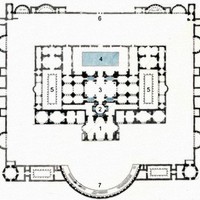
dal 1996 in continua innovazione tecnologica!
Sfrutta tecnologie avanzate per avere un sito web ottimizzato al 100%

The Baths of Diocletian (Thermae Diocletianae), the largest Spa of ancient Rome, were begun in 298 by the Emperor Maximilian, appointed Augustus of the Western Roman Empire by Diocletian, and open in 306, after the abdication of both. They were located between the present square of the Republic, Piazza del Cinquecento, via Volturno and Via XX Settembre, in a large area where conspicuous remains are still preserved.
They were the largest and sumptuous thermal baths built in Rome. Poses on the Viminale hill, in a 380 x 365 m fence, occupied almost 14 hectares, and in the fifth century Olimpiodoro claimed that they had 2400 tanks. The central block measures 250 x 180 m and could access the complex up to 3,000 people at the same time. To give an idea of their majesty, just remember that the semicircular colonnade of the square of the formerly Piazza Exedra (Republic), made in the late nineteenth century by Gaetano Koch, exactly follows the hemicycle of the Baths.
They were fed by a branch of the march that started from Porta Tiburtina and, with a journey arched used until 1879 by the Aqua Felix, led the water into a long tank more than 90 m, called the barrel Terms; was destroyed in 1876 to make room at Termini Station, which took its name from the "spa" itself.
The baths were built to serve the populous districts of the Quirinal, Viminal and Esquiline, and their realization was dismantled an entire neighborhood, with islets and private buildings regularly purchased and the disruption of the existing road system.
In 1560 the tepidarium was transformed into a church: in fact, it was in the hands of the ancient walls, a chapel devoted to the Angels and guarded by a monk. Meanwhile the Carthusians pressed for a new convent: Pius IV commissioned Michelangelo to exalt the chapel in the basilica and to design the Certosini convent, and in 1564 the first construction was completed. Thus was born Santa Maria degli Angeli and Martyrs.
For the Jubilee of 1575, Gregory XIII used the octagonal hall (already the Planetarium, then the cinema, and now integrated into the Roman National Museum) and three large classrooms to the basilica to make the new grain warehouses.
In 1754, Benedict XIV made the Church of Sant'Isidro at the Thermal Baths, which today only remains the entrance fašade.
source wikipedia

|
|

|
[ powered by Web Agency Pisa Internet Provider | HOTELS ITALIA | AZIENDE ITALIA | Posizionamento motori di ricerca ]